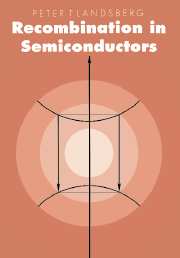Book contents
- Frontmatter
- Contents
- List of main symbols
- Note on units
- Introduction
- 1 Semiconductor statistics
- 2 Recombination statistics
- 3 Auger effects and impact ionization (mainly for bands)
- 4 Radiative recombination (mainly for bands)
- 5 Defects
- 6 Multiphonon recombination
- 7 Recombination in low-dimensional semiconductor structures
- Appendix A The delta function (section 3.2)
- Appendix B Useful identities arising from the periodic boundary condition (section 3.4)
- Appendix C Fourier expansions (section 3.4)
- Appendix D The effective mass sum rule and the dynamics of Bloch electrons (section 3.6)
- Appendix E Diagonalization and Jacobian for the threshold energy and impact ionization calculation (section 3.5.7)
- Appendix F The saddle-point method, and the method of stationary phase (section 6.3)
- Appendix G Evaluation of the integral (6.6.12) (section 6.6)
- References
- Index of names
- Index of topics, concepts and materials
- Frontmatter
- Contents
- List of main symbols
- Note on units
- Introduction
- 1 Semiconductor statistics
- 2 Recombination statistics
- 3 Auger effects and impact ionization (mainly for bands)
- 4 Radiative recombination (mainly for bands)
- 5 Defects
- 6 Multiphonon recombination
- 7 Recombination in low-dimensional semiconductor structures
- Appendix A The delta function (section 3.2)
- Appendix B Useful identities arising from the periodic boundary condition (section 3.4)
- Appendix C Fourier expansions (section 3.4)
- Appendix D The effective mass sum rule and the dynamics of Bloch electrons (section 3.6)
- Appendix E Diagonalization and Jacobian for the threshold energy and impact ionization calculation (section 3.5.7)
- Appendix F The saddle-point method, and the method of stationary phase (section 6.3)
- Appendix G Evaluation of the integral (6.6.12) (section 6.6)
- References
- Index of names
- Index of topics, concepts and materials
Summary
A systematic interest in recombination in semiconductors dates roughly from 1950 and gave rise for example to the Shockley–Read–Hall statistics in 1952 and the application of detailed balance to radiative processes in semiconductors in 1954. But our story really started with quantum mechanics and its application to solids. In contrast to its junior cousin, the black hole, the hole of semiconductor physics was first seen experimentally (in the anomalous Hall effect) and quantum mechanics was used to elucidate it [1]. Quantum mechanics was also used later to propose the band model of a semiconductor [2]. Actually, the copper oxide plate rectifier had been a useful solid-state device since the early days of quantum mechanics in the 1920s, but its action came to be understood only just before the war using electrons, holes and the band model [3]. This work has been reviewed for example by Mott and Gurney [4] and by Henisch [5]. Solid-state electronics was already in the air then, and rudimentary solid-state amplification had been proposed by Lilienfeld [6] in the late 1920s and established by Hilsch and Pohl [7] in 1938, using potassium bromide crystals. A useful semiconductor ‘triode’ was clearly ready to be born in 1938/9. But the war intervened. Still, solid-state detection was now important for radar, and programs to study silicon and germanium were initiated partly with government funding, notably at Purdue University under K. Lark-Horovitz.
- Type
- Chapter
- Information
- Recombination in Semiconductors , pp. 1 - 6Publisher: Cambridge University PressPrint publication year: 1992

